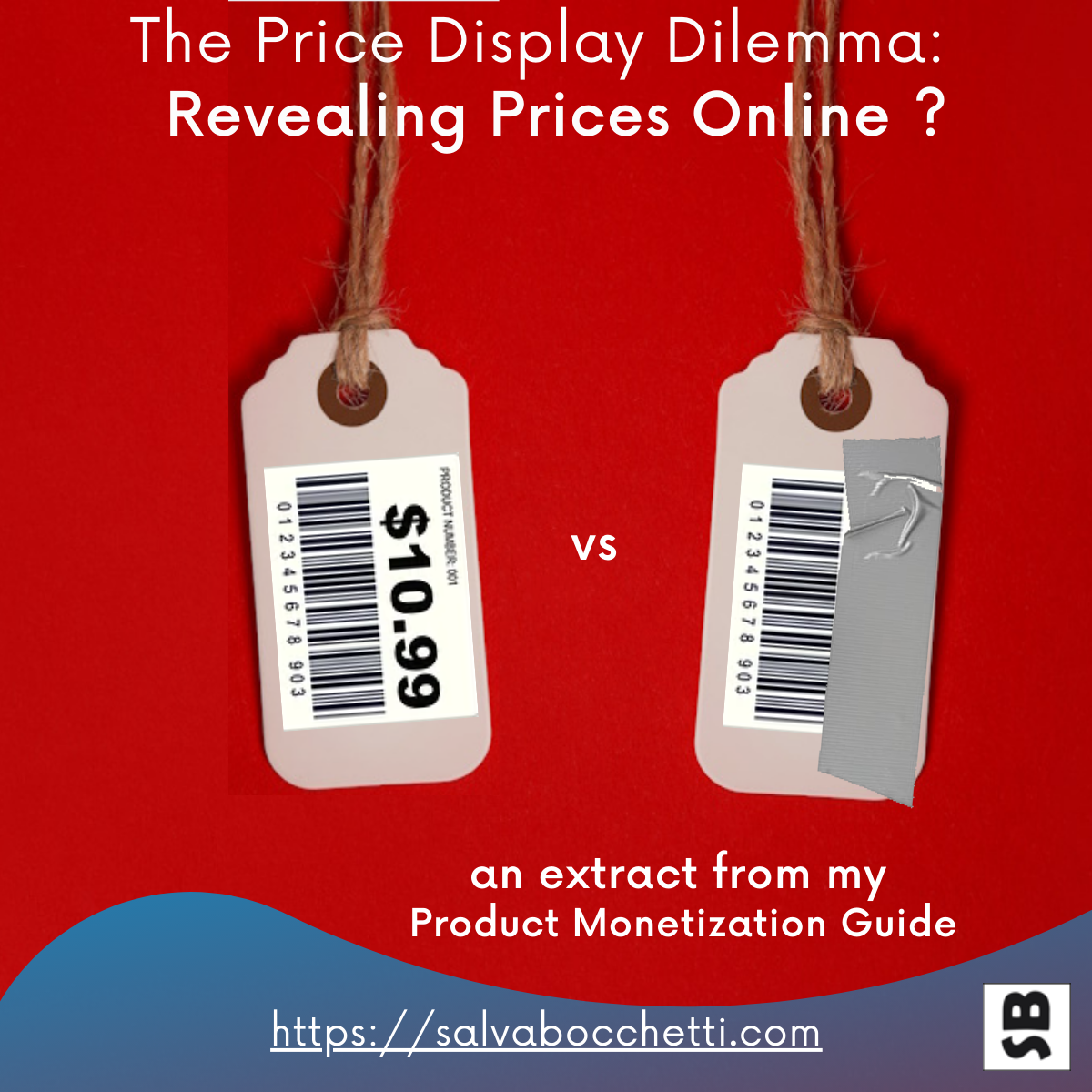The Price Display Dilemma: Unveiling the Pros and Cons of Revealing Prices Online
Shall companies display their prices online upfront or keep them hidden?
Companies, in particular the digital ones, invest massively in making products “self-service” to reduce the need for salespeople’s during the purchase journey. At the same time, consumers demand instant information and transparency about the products and services they’re interested in.
The question of whether companies should show or conceal their prices on their websites may seem redundant. That’s far from being the case. Both approaches have their staunch proponents, and, to be honest, there are pros and cons to both approaches.
In this article, we will delve into the key reasons why companies may choose to show or not their prices on their websites. We will explore the potential benefits and drawbacks of each approach, and examine how these decisions can impact various aspects of a company’s sales strategy.
Even if the question looks like a binary one, we will see alternative approaches that can be a valuable middle-ground.
The display of prices on a website has far-reaching implications. It impacts consumer behavior, brand perception, and overall business success and there is no one-size-fits-all answer. The right approach for each company and product depends on many factors such as:
- The target customers
- The kind of service
- The competition landscape
- The internal organization
Who shoes and who doesn’t show prices
There are categories of products and services where one of the two approaches is more prevalent than the other. Some industries and types of services are more commonly providing prices publicly, some others only after a personal conversation:
Industries that usually withhold prices:
- Consulting: Consultative services, such as management consulting, legal advisory, or financial planning, often require tailored solutions to meet clients’ needs. Prices are hence discussed after in-depth consultations, where clients’ requirements are thoroughly assessed, and customized proposals are presented.
- Highly Personalized Products/Services: Some offerings necessitate intricate integration or configuration. This is the case for enterprise software solutions, luxury items, or high-end interior design.
- Industrial and Specific Solutions: In industries like heavy machinery, industrial equipment, or large-scale infrastructure, pricing complexities are inherent due to the customization involved. Companies in these sectors prefer to withhold prices online to ensure they account for diverse specifications and project scopes accurately.
Transparent Pricing Industries:
- Classic SaaS Businesses (B2B and B2C): Software-as-a-Service (SaaS) companies often display their subscription plans and pricing tiers clearly on their websites. This approach fosters transparency, enabling potential customers to make informed decisions swiftly. In the B2B segment, this is particularly true for the SME sub-segment.
- Online and Digital Services (B2C): Companies selling B2C services like streaming, mobile subscriptions, and other digital goods usually show prices very prominently. Also, price is often a key selling argument and price transparency in these cases simplifies the decision-making process and is needed to trigger an immediate purchase.
- Retail and E-commerce: The retail sector, has naturally embraced the notion of transparent pricing as a standard practice. Consumers have grown accustomed to comparing prices quickly, and retailers find it advantageous to showcase prices prominently.
However, nothing is written in stone, there are exceptions and subtleties in each business that may justify a different approach. Adopting a different approach than the rest of the industry can be a way of differentiating yourself from the competition.
So, let’s see the reasons that will pull you in one direction or another.
Reasons to show prices online
In a world where consumers demand honesty and authenticity from businesses, price transparency emerges as a powerful tool to cultivate trust and foster a deeper connection with the customer base. Advocates of showing prices upfront argue that the benefits extend far beyond merely displaying figures; it lays the foundation for a more open, credible, and customer-centric approach to business. Let’s delve into the concrete advantages of price transparency and how it positively impacts various aspects of a company’s operations.
- Creates a clear “Call to Action”. You can’t finalize your purchase if you don’t know what you will pay. Display prices upfront and prominently, and present a clear “call to action” so that customers can complete the purchase in self-service.
- Facilitates Self-Service: In industries where products or services are more standardized or commoditized, such as certain B2C offerings, displaying prices upfront enables self-service and selling at scale. Customers can quickly evaluate options and make purchases independently, reducing the need for extensive sales interactions.
- Enhances the Clarity of Offer: For businesses, particularly those operating in the Software-as-a-Service (SaaS) industry, the pricing page becomes a central hub for potential customers seeking clarity on the available features and service tiers. By providing a clear breakdown of features and corresponding costs, businesses can effectively communicate their value proposition, making it easier for potential customers to assess suitability.
- Builds Trust and Transparency: Displaying prices openly sends a strong message of transparency and honesty. Customers appreciate businesses that are upfront about costs, seeing it as a sign of integrity and trustworthiness. This can contribute to a positive brand image, setting a company apart from competitors and cultivating long-term customer loyalty.
- Helps Packetization and Value-Based Pricing: Price transparency compels businesses, especially those selling services, to clearly define and package their offerings. By presenting prices alongside detailed deliverables, customers gain a better understanding of what they will receive, instilling confidence in the value of the service. This process also facilitates a move towards value-based pricing, where customers are willing to pay based on the perceived benefits they will receive.
- Provides a (High) Price Hook: Even if the final purchase has to be done through a sales rep, when prices are visible before initiating contact with a sales representative, prospects have the opportunity to digest the information at their own pace and create a mental hook of where the right price shall be.
- Pre-Qualification of Leads: The transparent pricing approach acts as a filter, automatically “pre-qualifying” leads. This means that potential customers who contact the business are already aware of the pricing and have deemed it acceptable, reducing the time and effort spent on non-viable leads.
Some examples of companies displaying prices online:
Purely B2C digital businesses are probably the most common example of companies offering a full self-service purchase journey and, of course, are very upfront about their prices.
At Spotify.com, for instance, you have full transparency about the different pricing plans. At the same time, don’t be fooled by the simplicity of the model. Spotify is NOT showing you all their prices and is personalizing prices for you. How? Geographical discrimination. Prices are different in each country: by the moment you look at the pricing page, Spotify has already “adapted” them to your country, for instance by looking at your IP address. The country is the proxy Spotify (and many other similar businesses) use to infer your willingness to pay.

A less obvious example of businesses showing prices online is within the consulting industry. Think about freelancing platforms such as Upwork.com: You mostly browse your preferred supplier looking for the right price:
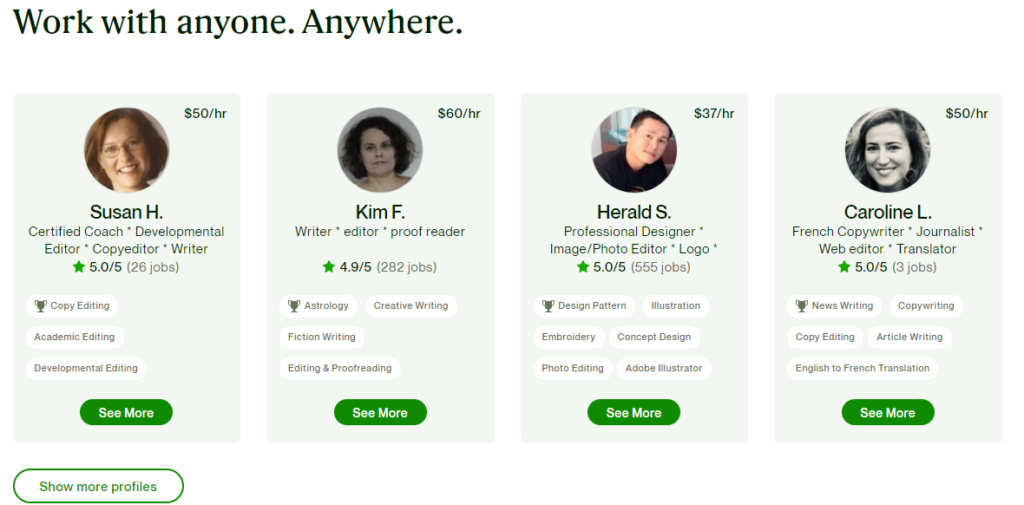
Reasons NOT to show prices online
Withholding prices can present a range of advantages, especially when it comes to personalized engagement. This approach centers on the belief that engaging customers personally and tailoring offers to their unique preferences and budgets, can yield superior customer experiences and foster higher levels of satisfaction and loyalty. Let’s delve into the concrete drawbacks of showing prices upfront and how businesses can leverage the power of personalized pricing to their advantage.
- Showing Value Before Price: Withholding prices initially enables businesses to first showcase the value of their offerings before revealing the cost. By emphasizing the benefits, features, and unique selling points, companies can create a stronger emotional connection with potential customers, motivating them to invest in the product or service based on its merits rather than its price alone.
- Avoiding Wrong Customer Hook: The price you display will engrave it in the minds of your customers. However, not all products or services are meant for every customer, and personalized pricing allows businesses to cater to individual needs. By engaging customers in direct conversations, companies can better understand their requirements and provide tailored solutions, avoiding the “hooking” of customers to price points that do not align with their needs (either too low or too high).
- Less Prone to Competitor Scrutiny: In fiercely competitive markets, publicly displayed prices can become targets for competitors to undercut or replicate. By keeping prices discreet until personalized interactions occur, businesses can maintain a degree of confidentiality, safeguarding their pricing strategies from immediate imitation.
- Supporting Price Discrimination: Personalized pricing allows companies to tailor pricing to individual customer segments, willingness to pay, or loyalty tiers. By catering to specific customer groups, businesses can create targeted pricing models that align with varying budgets and purchasing patterns, thereby maximizing revenue without alienating any particular customer segment.
- Flexibility in Negotiation: With fixed prices, negotiations are limited, and customers may feel less empowered to discuss terms. On the contrary, personalized pricing allows room for negotiation and compromise, providing customers with a sense of agency and potentially leading to mutually beneficial outcomes. Whether opening for negotiation is good or bad, really depends on the circumstances.
- Promotes Direct Customer Engagement: Withheld prices necessitate direct interactions with potential customers, promoting meaningful engagement and rapport-building. This human-centric approach can lead to deeper relationships, customer trust, and a greater understanding of customer needs and pain points.
- Capitalizing on Perceived Value: In certain cases, not revealing prices upfront can create an aura of exclusivity and premium quality around a product or service. Customers may perceive such offerings as high-value and superior, elevating their desire to be associated with them. Think about the luxury watches industry: the customer’s attention shall be on the feeling of exclusivity, not on the price.
- A new product/category: If you’ve recently launched a new product, having a deeper discussion with your customers may be an invaluable source of information to fix your pricing strategy. Moreover, there is likely less competition around and the likelihood of customers switching to another product just because of the additional hassle of going through a sales rep is minimum.

Do SaaS companies really hide prices in 2023?
Yes!
At Workday.com, for instance, the main call for action is “Contact Sales”. On their side, you will find a lot of products, solutions, and industries but no prices. Due to the completeness and complexity of their solution, the only way to see prices is through a personalized quote.

And Juro.com, a well-known contract management solution, has indeed a Pricing page where they show everything about their plans but… the prices! What is interesting there, is that the product does not really need a large degree of personalization, and showing prices online would indeed be possible.
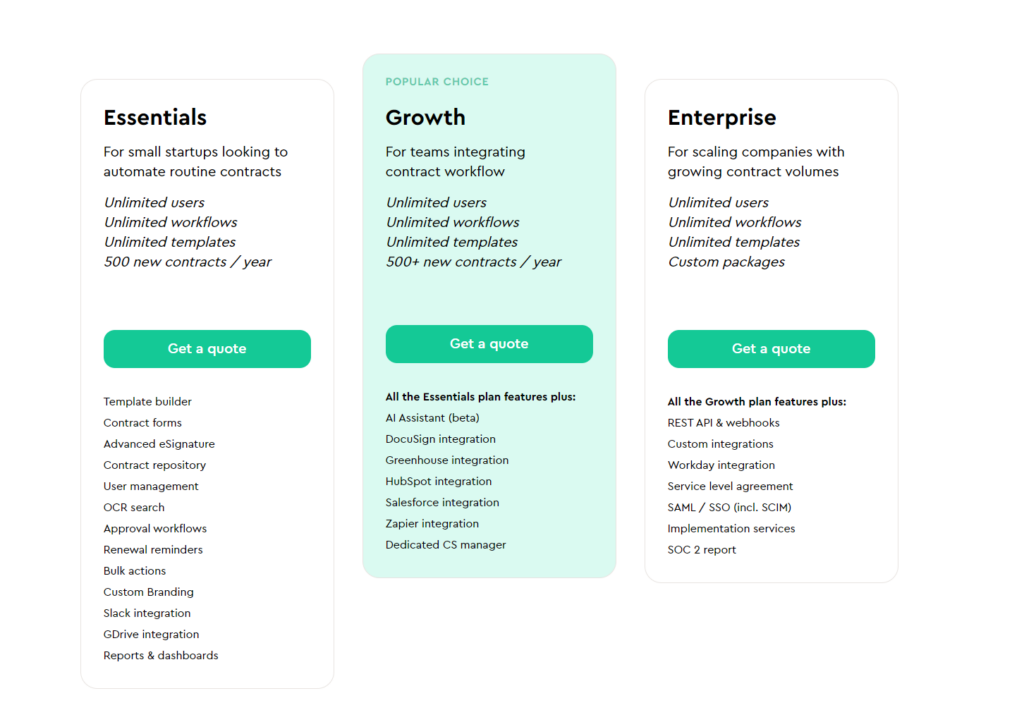
Alternative approaches
Life is not black or white, and so are prices. Alternative approaches to displaying prices exist, offering a more nuanced and dynamic pricing experience. These strategies allow companies to maintain transparency, highlight product value, foster personalized engagement, and capture valuable leads. Let’s explore some alternative pricing approaches that go beyond the simple dichotomy of showing or hiding prices.
- Show Prices Only for Some Products/Plans: Instead of adopting a one-size-fits-all approach, businesses can selectively display prices for specific product categories or service tiers. For instance, while displaying prices for standard products, a company may choose not to show prices for “corporate plans”. This strategy can maintain transparency while incentivizing potential customers to engage further with the sales team for tailored solutions. This is for instance what Docusign does with their “Enhanced plans”. Do you need SSO? Then you have to speak with the sales rep.
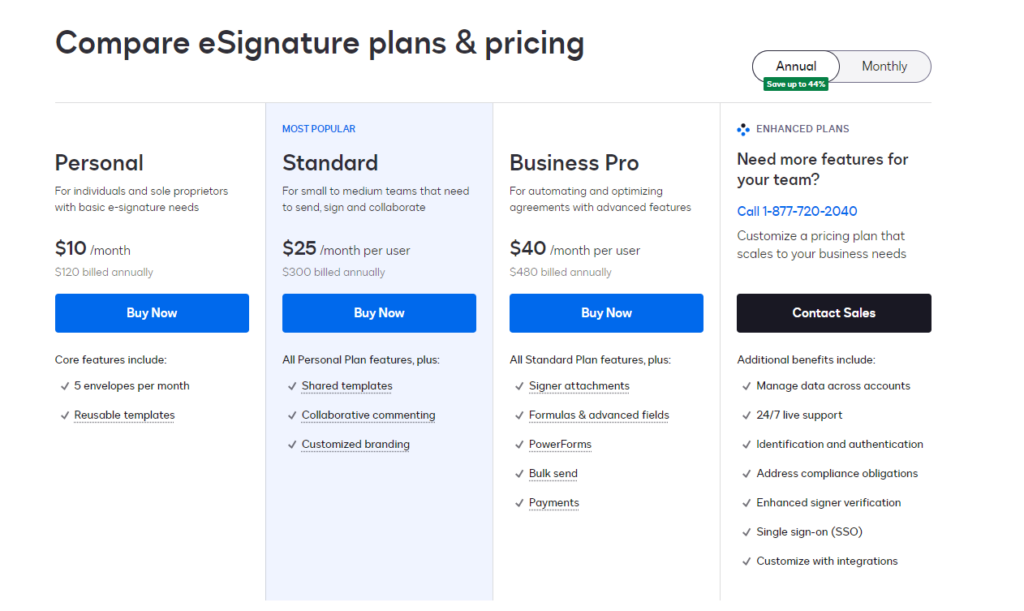
- Show Prices After Login: Some companies show prices only after customers log in or provide their email addresses. This approach allows businesses to capture valuable leads while offering potential customers a glimpse of their offerings. By providing a teaser of the product or service value, businesses can entice users to take the next step and initiate further interactions.
- Interaction unlocked price display: By delaying price display until after initial interactions, businesses can ensure that customers understand the value of their offerings before focusing on costs. For instance, you could show prices only after a trial has been started, or a certain number of interactions have happened. This approach encourages potential buyers to explore product features, benefits, and use cases, priming them for a more informed decision-making process
- Bot-Driven CPQ (Configure, Price, Quote): You can use an interactive, bot-driven CPQ system to allow customers to receive the price after a short conversation. The chatbot captures their needs, preferences, and budget constraints. Based on this input, the system then generates personalized quotes or pricing information. This approach ensures that customers receive tailored solutions while collecting valuable data for further follow-ups and marketing efforts.
- Dynamic/Differentiated Pricing: Businesses can implement dynamic and differentiated pricing models that adjust prices automatically based on environment, user segmentation, historical purchase behavior, or loyalty tiers. This approach enables companies to optimize revenue while delivering targeted pricing to specific customer groups.
- Bidding: We could consider this one as a particular case of Dynamic Pricing, aka Dynamic Pricing based on demand. In this model, the customer is not shown the actual price they will pay until the last moment. However, the customer has to “share” with the business their willingness to pay (for instance, their daily budget) and the system adapts and displays the unit price depending on the current demand and their budget.
Shall you use only one approach at a time?
We’ve seen how Spotify.com is pretty straightforward on its B2C prices and shows them openly on its website (although they do perform geographical discrimination). At the same time, their B2B offering (advertising) follows a different approach and is based on Bidding. In this model, the customer commits to a budget (read: willingness to pay) and can see a “low hook” (starting at $250) but the actual cost per unit (in this case, the CPC – cost per click) is “hidden” from the pricing page and evolves with demand. Yet, the system is fully self-service.
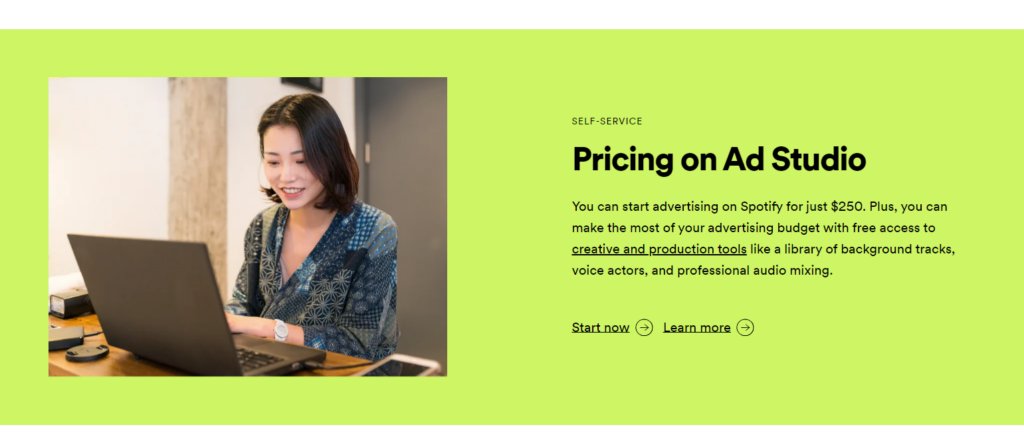
Conclusions
In the realm of products and services, the decision of whether to reveal prices upfront or engage customers in a one-on-one interaction remains highly contingent on the nature of the products or services offered.
While the general trends mentioned above hold, it is essential to recognize that exceptions abound in the business landscape. Subtleties unique to each company and industry might justify a deviation from the norm, leading some businesses to adopt unconventional pricing strategies.
Moreover, businesses should be aware that deviating from the industry’s standard practices can serve as a potent tool for differentiation. Embracing transparency in industries that traditionally rely on personalized pricing might set a company apart as refreshingly upfront and trustworthy.
Conversely, adopting a personalized approach in transparent pricing industries could underscore a commitment to customer-centricity and specialized service.
In conclusion, the decision to show or hide prices on a website should be grounded in a deep understanding of a company’s products or services, its target audience, and the broader industry dynamics.
Whatever the right approach for your company is, there is just one thing you should do: start thinking about your pricing strategy, and ensure you’re analyzing the different alternatives you have.

My name is Salva, I am a Product executive, helping tech companies discover, shape, and sell better Products. My work and writing are mainly about subscription models, product pricing, e-commerce/marketplaces, and creating top product organizations.
My superpower is to move between ambiguity (as in creativity, innovation, opportunity, and ‘thinking out of the box’) and structure (as in ‘getting things done’ and getting real impact).
I am firmly convinced that you can help others only if you have lived the same challenges: I have been lucky enough to practice product leadership in companies of different sizes and with different product maturity. Doing product right is hard: I felt the pain myself and developed my own methods to get to efficient product teams that produce meaningful work.

